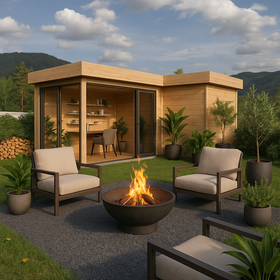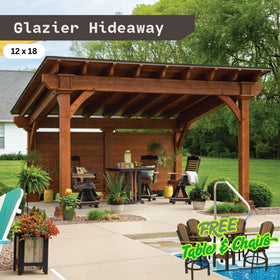512-777-0154

Designing Covered Outdoor Kitchen Structures
Outdoor kitchens look great in theory. Until the heat becomes unbearable. Or rain shows up just as you're prepping a meal. Then it’s a scramble to cover the grill and hope your stainless steel appliances haven’t taken on too much water.
Without a proper structure, patios turn into stress zones. Grilling feels rushed. Ovens don’t get used. Refrigerators get exposed to things they weren’t built for. And if you’ve ever had smoke drift into your living room, you know how fast outdoor cooking can affect your interior design.
That’s where a covered kitchen setup makes a real difference.
It gives the outdoor dining space structure. It shields your equipment. And it keeps your setup useful beyond the two perfect weeks of weather you get each season.
A good cover doesn’t just block wind or rain. It helps manage heat, improves airflow, and makes your entire design feel more intentional. Less like an afterthought. More like a space you want to use.
Because if you’re going to invest in an outdoor kitchen, it should work just as hard as the one inside.
1. What Makes a Covered Outdoor Kitchen Worth It?

A covered outdoor kitchen isn’t just about aesthetics. It’s about being able to use the space when you want to.
Rain? You can still cook. Wind? It’s not blowing out your fire pit or your mood. Hot summer day? The shade helps keep things bearable. You’re not melting while flipping burgers.
It also means your grills, kitchen cabinets, and bar stools won’t wear out as fast. A roof adds protection. And a bit of structure. It gives the whole room a sense of purpose, even if it’s outside.
You’ll also notice a difference in airflow and smoke control. Especially if your layout includes a covered Alfresco Grills 56″ Deluxe Grill Built-In or pizza oven. No more smoke wafting toward the open window or the neighbor’s yard.
And yes, it makes entertaining easier. Lunch in the rain. Dinner under string lights. A few quiet minutes by the fire pit without checking the weather every five seconds.
If you’re doing an outdoor kitchen remodel, this part deserves a spot at the top of your list. It’s what turns a backyard setup into an outdoor cooking oasis.
2. Before You Build Anything, Think About These Things First
- What’s the weather like where you live? Climate affects everything. If it rains often, or your deck is exposed to strong wind, you’ll need more coverage. Sunny backyard? Shade matters. Snow? You'll want a solid roof and weatherproof materials.
- What are you really going to use it for? Grilling for two? Hosting big family meals? Just need a spot near the swimming pool for snacks and drinks? Be honest about how it’ll get used, or you’ll end up with a setup that looks good but sits empty.
- How much space do you have? A small garden might only fit a Memphis Grills Elevate™ 30" Freestanding Pellet Grill and prep area. A larger yard opens the door for an outdoor fireplace, bar seating, or even a full dining zone. Don’t forget the walking space.
- Any HOA or building restrictions? Permits. Setbacks. Height rules. Not fun, but important. Especially if your design includes a roof, metal framing, or anything near a fence line.
- How much of the kitchen needs to be covered? Just the cooking area? A full dining setup? The bar? More coverage usually means more comfort, better airflow, and a higher budget.
Sketch out a rough plan. Think of it as your first real tool in the process.
3. Choosing the Right Type of Cover
Choosing the right cover isn’t just about style. It affects how you use the space, how much protection you get, and how well everything holds up over time. Some setups handle rain and heat better. Others are more about aesthetics and airflow.
Pergolas: Light Shade, Stylish Vibes
Pergolas are open-roof structures with spaced-out beams. They’re great if you want partial shade without blocking everything out. A solid choice for ventilation, especially if your barbecue or rotisserie gets a lot of use.
They work well for a pergola kitchen that focuses on airflow and simplicity. Add climbing plants or lighting between the beams if you want to dress it up a bit.
Just keep in mind, they’re not fully waterproof. In rainy climates, this setup can leave your furniture, countertop, or dishwasher exposed.
Gazebos: Fully Covered and Freestanding
Gazebos offer full coverage with a defined roof pitch and solid walls or posts. If you’re planning an outdoor gazebo kitchen with a covered grill station and built-in seating, this structure handles it well.
It protects your wood cabinets from rain and reduces corrosion on metal appliances. It also makes lighting more flexible since you’ve got a solid ceiling.
The trade-off? They take up more space and can look oversized in small yards.
Roof Extensions: Seamless, but Involved
These connect directly to your house and create a unified look. They’re usually built with matching materials like brick or wood to blend into your existing design.
Roof extensions are great for durability, drainage, and structure. But they’re more involved. You’ll likely need permits. You’ll also need to plan for proper ventilation if you're installing a grill station underneath.
This style is best for patios that feel like a true extension of your interior layout.
Retractable Awnings: Flexible and Functional
Awnings are ideal if you want something that adjusts to the weather. Shade when you need it, open air when you don’t. Some even come with built-in lighting or remote controls.
But they’re not perfect. Durability can be an issue in high winds or heavy rain. And they don’t offer the same long-term protection as a fixed structure.
Still, if your goal is flexible coverage for a smaller deck or casual space, they’re a practical tool to have.
4. Don’t Skip These Materials

The materials you choose for your cover will either save you time or slowly drive you up the wall. And replacing warped beams or cracked tiles isn’t exactly how most people want to spend their weekends.
Start at the top. Roofing options like polycarbonate panels let in light but block UV rays. Cedar shingles give a natural look but need more maintenance. Metal works well for durability and weather resistance, especially in a covered outdoor BBQ area or canopy-style setup.
Framing matters. Pressure-treated wood is common, but it can age quickly if not sealed. Aluminum and steel hold up better in wet climates and can handle heavy loads. Useful if your design includes a covered patio with kitchen on a second-level balcony or deck.
Flooring needs attention. Concrete is reliable and low-maintenance. Stone adds texture. Tile looks sleek, but skip anything too polished; wet feet and slick surfaces don’t mix, especially near a charcoal grill or open flame.
If you're going for an outdoor pavilion kitchen look, aim for materials that hold up in the sun, wind, and moisture. UV-stable, low-corrosion, and easy to clean.
Think like a chef setting up a new pantry. It’s not just about what looks good. It’s about what works long term. Especially if you're cooking near glass doors or need your layout to stay sharp season after season.
5. Lighting, Fans, and Real-World Comfort

Once the construction is done, the big stuff gets all the attention. But it’s the smaller details that make your space actually enjoyable to use.
Start with airflow. A ceiling fan can help move smoke from the grill and keep bugs from settling in. It also helps when you're trying to enjoy outdoor dining without sweating through dinner.
Lighting matters too. Overhead string lights are great for atmosphere, but they won’t cut it for actual cooking. Add a mounted fixture or two over the sink or granite prep area so you’re not chopping in the dark.
Live in a colder climate? Consider a mounted heater. Especially if your layout leans toward a covered patio kitchen or outdoor covered patio with a fireplace and kitchen setup. It extends the season and makes the space feel more like a sunroom or second dining room.
And if this is more than just a quick-grill setup, think couch, music, maybe a mounted TV, those things need planning.
Outdoor Kitchen Design Ideas to Spark Inspiration

- Rustic and natural: Think stone counters, thick wood beams, and muted, earthy tones. Durable building materials that blend well with a kitchen garden or open backyard.
- Modern and minimal: Sleek metal framing, flat roofs, and a clean color palette. Prioritizes usability and flow. Great for small spaces or anyone leaning toward minimalism.
- Tropical retreat: Thatched roof. Bamboo walls. Light fabrics that move in the breeze. Easy to pair with plants, potted trees, or a sand-colored paver floor.
- Farmhouse cozy: White cabinetry, wood counters, and soft lighting. Add in string lights and vintage-style finishes for charm. Works well under classic rooflines or a simple gable setup.
- Budget-friendly basics: A simple DIY pergola, portable grill, and concrete slab. Doesn’t try too hard. Just gets the job done with smart layout and affordable materials.
The best setups borrow ideas from more than one style. Match your architecture, weather, and taste. You’re building something that works for how you live or how you dream about living.

Covered Outdoor Kitchen Plans Start Simple
You don’t need a massive layout or a designer price tag to make it work. Even a small cover over the grill can change how often you use your space. It keeps things dry, manageable, and a lot more enjoyable when the weather shifts.
Start with structure. Think about airflow, roof style, and layout. Then you can layer in lighting, furniture, and all the extras that make it feel like your own.
If you're looking for more ideas, check out the rest of our blogs. There's plenty in there to get your plans moving. And comfortable enough to keep you there.
If you're looking for more ideas, check out the rest of our blogs. There's plenty in there to get your plans moving.






